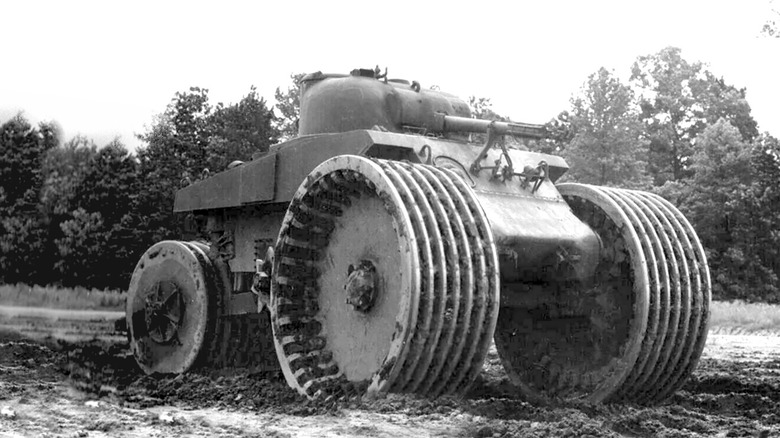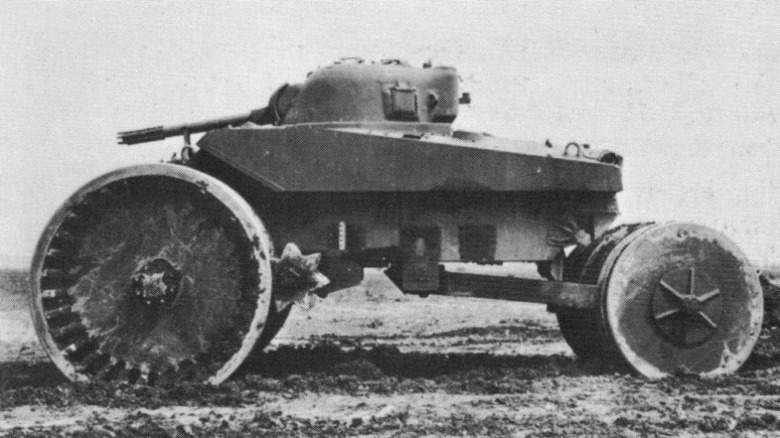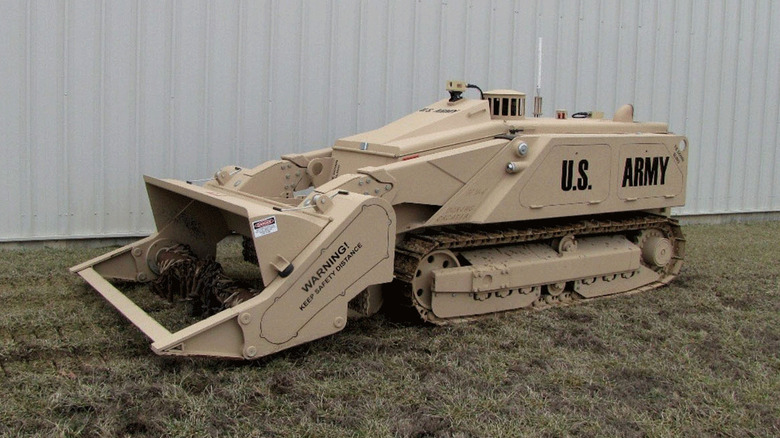The Worlds Toughest Tricycle: The Big Foot M4 Sherman T10 Tank
In the world of peculiar military vehicles, the M4 Sherman T10 Mine Exploder Tank has to rank near the top. Developed as a variant to the iconic M4 Sherman Tank, the T10 Mine Exploder was created in the 1940s during World War II to help Allied troops sweep for mines in preparation for the Battle of Normandy. An invaluable tool for helping ground troops and other light armored vehicles make it through the battle lines, this strange tricycle never actually saw combat.
What is initially apparent — and was obvious back then — is that the Big Foot M4 Sherman T10 is unlike other M4 Sherman variants, with two huge wheels on the front and a smaller, closer set of wheels on the back, which makes it look strikingly similar to a tricycle. Ironically, this strange design would also be one of the reasons these American military tanks would never actually be commissioned for combat. Eventually, the M4 Sherman T5E3 replaced it as it provided much more reliable and safe methods of mine clearing.
What was the Big Foot M4 Sherman T10 Tank?
During WWII, Allied forces faced a serious roadblock in taking territory quickly during the early stages of the Battle of Normandy. Axis forces had laid vast minefields that would impede troops, and clearing the fields had to be done quickly to avoid losing momentum. The solution was to produce an armored vehicle capable of sweeping mines quickly to allow for safe travel for supply vehicles and infantry.
While British forces worked on flailed models that would go on to influence mine-sweeping vehicles used today, the Fisher Body Division of General Motors adapted the popular M4 Sherman to develop the Big Foot M4 T10 based on earlier tricycle designs from the United States National Defense Research Committee. The vehicle used an M4 Sherman body but stripped the tank of its tracks and replaced them with two oversized 96-inch rollers in the front and a set of smaller 72-inch rollers on the back of the vehicle.
To make room for the large wheels, the tank's armor was reduced at the front of the sponsons, and the floor thickness was increased to 25-millimeter steel to help absorb the impact of detonated mines, even though the Big Foot itself was remote-controlled. The tank weighed over 100,000 pounds and could reach a maximum speed of 6.8 mph while clearing mines. While the 75-millimeter gun mounted at the top of the tank was retained, it served no purpose as it couldn't be used while remote-controlled.
What happened to the Big Foot M4 Sherman T10 Tank?
Unfortunately, the odd design of the M4 Sherman T10 Tank likely contributed to its not being used in combat. In 1944, the T10 was tested and was deemed unsatisfactory. While the two rollers in the front were powered, the wheels in the back were not, which would cause the slow-moving vehicle to get stuck, especially in softer terrain like mud. Ultimately, the tank would never be deployed or produced, and the design would be scrapped for the T5E3, which had a bulldozer blade in the front and was meant to push the mines to the sides of the road.
However, that concept would eventually be deemed ineffective, and the flailed concept for an armored mine detonator would become the more popular design. Today, models like the M160 Robotic Mine Flail, which the United States Army utilizes, are used to clear minefields. These vehicles are protected with thick armor plating and have rotating chained hammers that dig into the soil, detonating the devices. Interestingly enough, not everything from the Big Foot M4 Sherman T10 was a bad idea, as today, these mechanical mine detonators are also remote-controlled.


